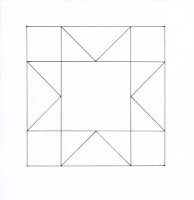
It's been a busy summer for bunting, from the Diamond Jubilee to the
great British Sporting Summer. At a stretch, the patriotic
bunting can probably be left up until after the Last Night of the Proms, but any longer is probably pushing it.
But I don't think the end of the summer means we have to pack up the bunting for good. There is something about seeing bunting hanging up that
lifts the spirits with its positive associations of celebration. I have long wanted to make my own bunting, but (like so many other projects) finding the time is another matter.
Below are two bunting projects I have recently completed. They are simple to do, relatively quick and the possibilities to adapt them are endless. You don't need a sewing machine, or even a needle and thread.
Welcome bunting banner
This project actually started with the ribbon. Having bought some pretty ribbon in a Cath Kidston sale, I was thinking of how best to use it. It didn't take long to decide that it would be a lovely starting point for a welcome bunting banner.
First, I measured a template for the size of the bunting triangles (16x19cms approx) and cut these out ready to decorate. Once I had decided the size of the bunting triangles I could make the stencils. I started by sketching out the letters and pictures. Once I was happy with the design of these, I traced these sketches onto card. Then came the tricky bit: cutting the patterns out. A steady hand is needed!
I used a sponge and watercolour paints, choosing bright shades to complement the colours in the ribbon. Once dry, I laid out the triangles, cut the ribbon to the required length and stapled the triangles to the back of the ribbon. The triangles overlap slightly behind the ribbon.
 This bunting is not perfect, but I am really glad I tried.
This bunting is not perfect, but I am really glad I tried. There is the odd touch of paint where there shouldn't be, but letting that go, the overall effect is rather jolly. I was a bit worried that once finished this bunting would look twee, but I think it manages to avoid that.

I have to admit that I am particularly pleased with the teapot and tea
cup
prints, which look more effective than I had anticipated they would.
Using repeats of these two images could potentially make some lovely
bunting - possibly a future project!
Over time you can gradually build up a good collection of home made stencils.
Stencil bunting could be great for displaying a Happy Birthday message, or putting a child's name on their bedroom door.
Literary bunting
A craft fair I visited this summer had lines of bunting decorated with limericks hanging from the ceiling in a nod to a local poetry festival. I liked the idea of decorating bunting with text and thought I would try it out for myself at home.
As I intended to hang the bunting between my kitchen and dining area, I decided to go with a food theme. I had a lot of fun going through books to try to locate passages that I half-remembered. There were lots of passages to choose from, and the final line-up includes text from Wodehouse, The Wind in the Willows, Swallows and Amazons, Gerald Durrell, the Worst Witch and Winnie-the-Pooh.

This bunting is very easy and quick to make. Having drawn up a template so I knew the size of the triangles I had to fill (15.5x18cms approx), I typed up my chosen extracts so that I could influence their layout on the page (if layout is not a concern time could be saved by scanning the pages instead). These were then printed onto card and the triangles cut out. I cut out the bunting triangles so that the text appears at different angles on a couple of the triangles.
Again, the possibilities are endless. Decorate bunting with favourite recipes for the kitchen, nursery rhymes for a child's room or Christmas carols to add to a festive atmosphere.
So go on, hang out the bunting!

 To make the decoration you will also need felt in brown, white and green, ribbon, buttons, stuffing and thread.
To make the decoration you will also need felt in brown, white and green, ribbon, buttons, stuffing and thread.








































